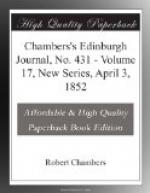’Meantime, the science of meteorology—a subject intimately connected with that of aero-locomotion—though yet in its infancy, already furnishes many indications of great importance, as establishing a very strong presumption in favour of the existence of permanent atmospheric currents, blowing continuously in various directions at different degrees of elevation.
’We know that air, when rarefied by heat, becomes lighter and rises, cold air immediately rushing in to supply its place; and it is evident, therefore, that if two neighbouring regions of the atmosphere are unequally heated, this inequality of temperature will give rise to two currents of air—a warm one, in the upper region of the atmosphere, blowing from the warmer to the colder region; and a cold one, near the surface of the earth, blowing from the colder to the warmer region. It can, therefore, hardly be matter of doubt, that great permanent currents, caused by the unequal heating of the equatorial and polar regions, do exist in the higher strata of the atmosphere—an inference which is supported not only by the occurrence of the trade-winds and the monsoon, but by a variety of other facts and observations.
’Thus, for instance, it is found that in the region of the trade-winds, cinders from the craters of volcanoes, and other objects, are carried through the higher regions of the air in a direction exactly opposite to that in which the trade-wind itself is blowing below; and in this way cinders from the Cosiguina, in Guatemala, frequently fall in the streets of Kingston (Jamaica), lying to the north-east of Guatemala. Similar facts have been observed at the Peak of Teneriffe, in the Straits of Magellan, and elsewhere.
’The importance of this subject with regard to aero-locomotion can hardly be overrated; for these currents, when clearly ascertained and correctly mapped out, would constitute so many great natural routes, where the aeronaut would be borne onward in the required direction with immense velocity, and without danger of encountering squalls or counter-currents.
’But here, fearful of exhausting the patience of our readers, we bring our somewhat lengthened disquisitions to a close, and take our leave for the present of the tempting, though debatable ground of the CUBIC HIGHWAY.’
A MEMOIR FOR THE MILLION.
On the meeting-line between a moorland and lowland district of Perthshire, stands an old baronial seat, dignified with the name of castle, to which, no doubt, it was entitled long after the date of its erection, in the fifteenth century, although no longer boasting of either the strength or magnificence which such a name implies. Its position, however, is picturesque—standing on the bank of a romantic and finely-wooded Highland glen, and commanding a view on one side of a mountain-range, and on the other of a cultivated country, with its towns and villages in the distance. The mansion




